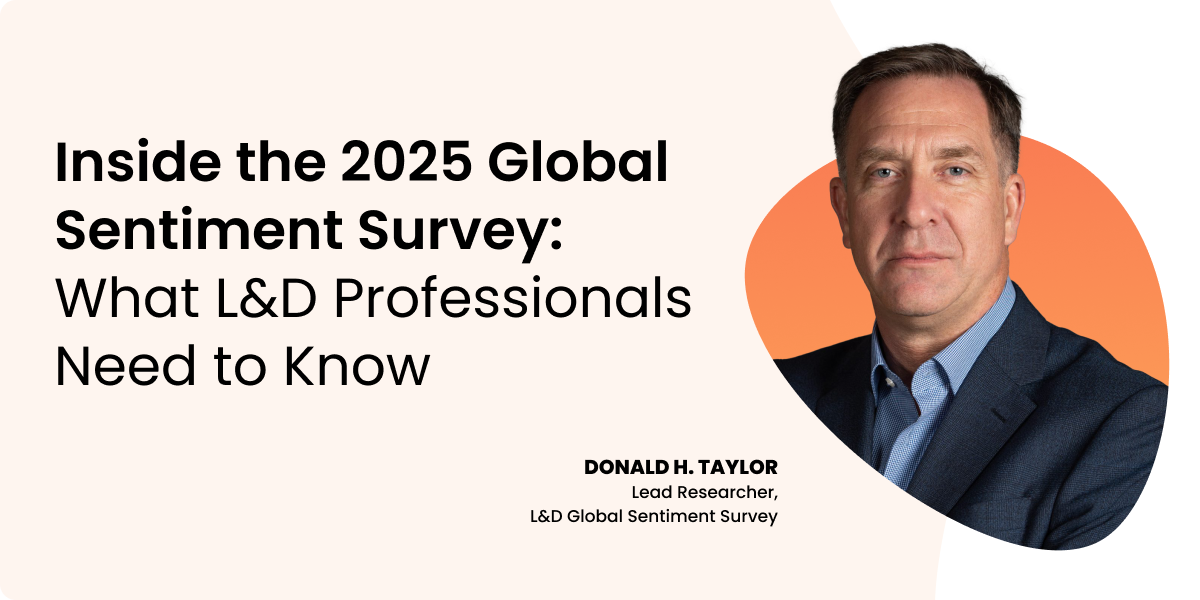What’s top of mind for learning and development (L&D) professionals worldwide in 2025? OpenSesame hosted a webinar series that explored this question and brought together over 200 attendees and featured special guest Donald H. Taylor, Lead Researcher of the Global Sentiment Survey.
Donald is a globally recognized thought leader in L&D, known for chairing the Learning Technologies Conference and founding the influential L&D Global Sentiment Survey. With decades of experience and roles advising EdTech start-ups and industry boards, he brings deep insight into the trends shaping the future of workplace learning.
Now in its 12th year, the Global Sentiment Survey asks the same question annually: What will be hot in L&D in the coming year? In 2025, 3,339 participants across 93 countries selected up to three options from a list of 16, including AI, microlearning, and upskilling. These results highlight what early adopters and innovators in L&D are most excited about.
Together, these insights help L&D teams spark conversations and shape the direction of their learning strategies.
Download the 2025 Global Sentiment Survey Report here.
What L&D professionals need to know: Five takeaways from this year’s webinars
AI holds its spot as L&D’s hottest trend
AI led the vote with 22.6%—the highest in the history of the survey and a 1.1% increase from last year. Among the 16 key countries with the most respondents, which together account for 77% of the total vote, every single one ranked AI as their top trend.
“I didn’t think it was possible to go larger than last year, so that was extraordinary.”
– Donald H. Taylor, Lead Researcher of the L&D Global Sentiment Survey
While AI topped the global rankings, AI-focused responses from the United States dropped by more than 3%. Donald noted this result was unexpected, and it could signal a shift ahead. Historically, the U.S. tends to influence results worldwide, so while it’s too early to predict, a broader decline in AI’s dominance may be on the horizon.
L&D’s relationship with AI is maturing
One reason AI continues to dominate, overall, is that L&D professionals are becoming more confident in utilizing it. In 2024, 60 people listed simply “AI” as their biggest challenge, but this year, only three cited it. Instead, more respondents cited very specific AI-related roadblocks—suggesting that L&D teams are moving beyond uncertainty and exploring practical applications. As Donald noted, this shift reflects a more sophisticated understanding of AI across L&D professionals.
The “value trio” makes a comeback
Outside of AI, only three options saw an increase in votes this year: “Consulting more deeply with the business,” “Performance support,” and “Showing value”—a group Donald calls the “value trio.” He believes these options are connected in people’s minds, as they’ve consistently moved together over time and avoided declines most trends see. After a dip in 2024 during the peak of AI hype, all three bounced back in 2025, regaining nearly everything they lost.
With AI evolving quickly, Donald believes many L&D professionals feel pressure to prove their impact before their roles are replaced or redefined. The value trio’s rise suggests an effort to highlight the uniquely human contributions L&D brings to the table.
Europe, the Middle East and Africa’s (EMEA) long-term L&D trends are back
Similar rebounds occurred across individual countries in the EMEA. After a long period of predictability, followed by a dip during the AI shock—a time when AI dominated attention—many L&D trends have recovered and regained momentum. In the Netherlands, Performance support” followed a rebound pattern. In Ireland, it was “Coaching and mentoring.” In the UK, “Showing value” was already rising—until the AI shock caused a dip, followed by a strong recovery.
No one-size-fits-all: L&D looks different across EMEA
Even neighboring countries can show vastly different L&D priorities. The UK focuses heavily on “showing value,” while Ireland emphasizes “coaching and mentoring”. Belgium leans toward “personalization,” unlike the Netherlands, which favors “performance support.” Poland is strong on “microlearning,” whereas Germany prioritizes “skills-based talent management.” Proximity doesn’t equal similarity, which is reflected in the survey results.
“There are times across Europe where we’ve got these neighbors who may speak the same language, but who do things in different ways,” Taylor said.
Donald H. Taylor, Lead Researcher of the L&D Global Sentiment Survey
The Global Sentiment Survey is more than a snapshot—it’s a pulse check on where L&D is headed and the challenges professionals face. AI may be in the spotlight, but renewed efforts to prove impact and regional differences show that L&D remains a complex and constantly evolving space.
If you’re looking to dig deeper into the data and hear Donald’s take firsthand, watch the full webinar to explore the global trends shaping the L&D industry here. For insights specific to the EMEA region, watch the EMEA-focused session here.

